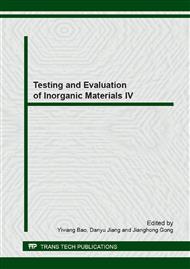[1]
J.C.O. Villanova, E. Ayres, R.L. Oréfice, Design of prolonged release tablets using new solid acrylic excipients for direct compression, Europ. J. Pharm. Biopharm. 79 (2011) 664–673.
DOI: 10.1016/j.ejpb.2011.07.011
Google Scholar
[2]
A.B. Joshi, S. Patel, A.M. Kaushal, A.K. Bansal, Compaction studies of alternate solid forms of celecoxib, Advanced Powder Technology. 21 (2010) 452–460.
DOI: 10.1016/j.apt.2010.01.006
Google Scholar
[3]
F. Podczeck, Methods for the practical determination of the mechanical strength of tablets — From empiricism to science, International Journal of Pharmaceutics. 436 (2012) 214–232.
DOI: 10.1016/j.ijpharm.2012.06.059
Google Scholar
[4]
L. Chen, U.L. Opara, Texture measurement approaches in fresh and processed foods — A review, Food Research International. 51 (2013) 823–835.
DOI: 10.1016/j.foodres.2013.01.046
Google Scholar
[5]
F. Fichtner, A, Rasmuson, G. Alderborn, Particle size distribution and evolution in tablet structure during and after compaction, International Journal of Pharmaceutics. 292 (2005) 211–225.
DOI: 10.1016/j.ijpharm.2004.12.003
Google Scholar
[6]
I. Stoltenberg, J. Breitkreutz, Orally disintegrating mini-tablets (ODMTs) – A novel solid oral dosage form for paediatric use, Europ. J. Pharmaceutics and Biopharmaceutics. 78 (2011) 462–469.
DOI: 10.1016/j.ejpb.2011.02.005
Google Scholar
[7]
A.S. Narang, V.M. Rao, H. Guo, J. Lu, D.S. Desai, Effect of force feeder on tablet strength during compression, International Journal of Pharmaceutics. 401 (2010) 7–15.
DOI: 10.1016/j.ijpharm.2010.08.027
Google Scholar
[8]
A. Gryczke, S. Schminke, M. Maniruzzaman, J. Beck, D. Douroumis, Development and evaluation of orally disintegrating tablets (ODTs) containing Ibuprofen granules prepared by hot melt extrusion, Colloids and Surfaces B: Biointerfaces. 86 (2011).
DOI: 10.1016/j.colsurfb.2011.04.007
Google Scholar
[9]
Y. Okuda, Y. Irisawa, K. Okimoto, et al., A new formulation for orally disintegrating tablets using a suspension spray-coating method, International Journal of Pharmaceutics. 382 (2009) 80–87.
DOI: 10.1016/j.ijpharm.2009.08.010
Google Scholar
[10]
R.M. Pabari, Z. Ramtoola, Application of face centred central composite design to optimise compression force and tablet diameter for the formulation of mechanically strong and fast disintegrating orodispersible tablets, International Journal of Pharmaceutics. 430 (2012).
DOI: 10.1016/j.ijpharm.2012.03.021
Google Scholar
[11]
S. Mehta, T. De Beer, J.P. Remon, et al., Effect of disintegrants on the properties of multiparticulate tablets comprising starch pellets and excipient granules. Int. J. Pharm. 422 (2012) 310–317.
DOI: 10.1016/j.ijpharm.2011.11.017
Google Scholar
[12]
A. Hegedus, K. Pintye-Hodi, Comparison of the effects of different drying techniques on properties of granules and tablets made on a production scale, Int. J. Pharm. 330 (2007) 99–104.
DOI: 10.1016/j.ijpharm.2006.09.001
Google Scholar
[13]
F. AlHusban, Y. Perrie, A.R. Mohammed, Formulation of multiparticulate systems as lyophilised orally disintegrating tablets, Europ. J. Pharmaceutics and Biopharmaceutics. 79 (2011) 627–634.
DOI: 10.1016/j.ejpb.2011.05.014
Google Scholar
[14]
S.P. Simonaho, T.A. Takala, M. Kuosmanen, J. Ketolainen, Ultrasound transmission measurements for tensile strength evaluation of tablets, Int. J. Pharm. 409 (2011) 104–110.
DOI: 10.1016/j.ijpharm.2011.02.033
Google Scholar
[15]
P. García-Triñanes, M. Bao, J.J. Casares, T. Ittershagen, M. Morgeneyer, Study on the mechanical strength of primary carbonate tablets, Powder Technology. 204 (2010) 124–130.
DOI: 10.1016/j.powtec.2010.07.027
Google Scholar
[16]
F. Fichtner, A.C. Rasmuson, E.M. Alander, et al., Effect of preparation method on compactability of paracetamol granules and agglomerates, Int. J. Pharmaceutics. 336 (2007) 148–158.
DOI: 10.1016/j.ijpharm.2006.11.046
Google Scholar
[17]
M.G. Herting, P. Kleinebudde, Studies on the reduction of tensile strength of tablets after roll compaction/dry granulation, Europ. J. Pharm. Biopharm. 70 (2008) 372–379.
DOI: 10.1016/j.ejpb.2008.04.003
Google Scholar
[18]
J. Vercruysse, D.C. Díaz, E. Peeters, et al., Continuous twin screw granulation: Influence of process variables on granule and tablet quality, Europ. J. Pharm. Biopharm. 82 (2012) 205–211.
DOI: 10.1016/j.ejpb.2012.05.010
Google Scholar
[19]
L. Farber, K.P. Hapgood, J.N. Michaels, et al., Unified compaction curve model for tensile strength of tablets made by roller compaction and direct compression, Int. J. Pharm. 346 (2008) 17–24.
DOI: 10.1016/j.ijpharm.2007.06.022
Google Scholar
[20]
M. Dumarey, H. Wikström, M. Fransson, et al., Combining experimental design and orthogonal projections to latent structures to study the influence of microcrystalline cellulose properties on roll compaction, International Journal of Pharmaceutics. 416 (2011).
DOI: 10.1016/j.ijpharm.2011.06.018
Google Scholar
[21]
N. Kottala, A. Abebe, O. Sprockel, et al., Influence of compaction properties and interfacial topography on the performance of bilayer tablets, Int. J. Pharmaceutics. 436 (2012) 171–178.
DOI: 10.1016/j.ijpharm.2012.05.026
Google Scholar
[22]
A. Siddiqui, S. Nazzal, Measurement of surface color as an expedient QC method for the detection of deviations in tablet hardness, International Journal of Pharmaceutics. 341 (2007) 173–180.
DOI: 10.1016/j.ijpharm.2007.04.006
Google Scholar
[23]
S. Lakio, S. Siiriä, H. Räikkönen, et al., New insights into segregation during tabletting, International Journal of Pharmaceutics. 397 (2010) 19–26.
DOI: 10.1016/j.ijpharm.2010.06.041
Google Scholar
[24]
Z. Rahman, A.S. Zidan, M.A. Khan, Risperidone solid dispersion for orally disintegrating tablet: Its formulation design and non-destructive methods of evaluation, Int. J. Pharm. 400 (2010) 49–58.
DOI: 10.1016/j.ijpharm.2010.08.025
Google Scholar
[25]
I. Akseli, C. Cetinkaya, Air-coupled non-contact mechanical property determination of drug tablets, International Journal of Pharmaceutics. 359 (2008) 25–34.
DOI: 10.1016/j.ijpharm.2008.03.020
Google Scholar


